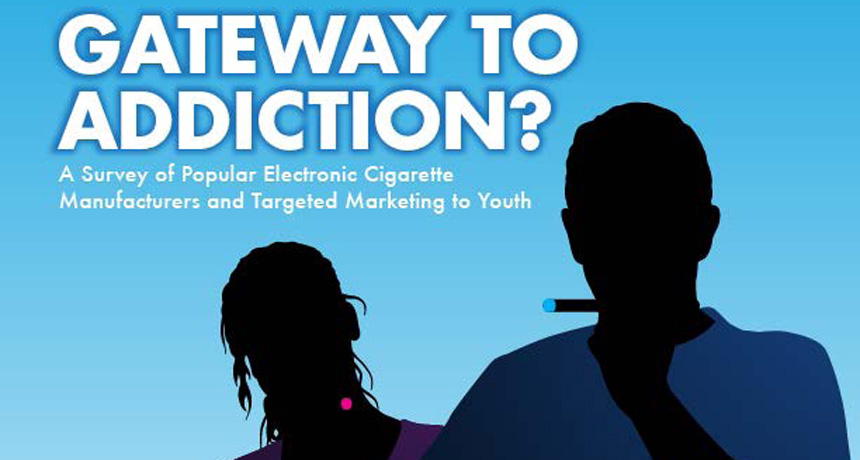According to the Centers for Disease Control and Prevention, 13% of high school age students used e-cigarettes in 2014, up from 4% in 2013. Regulation is being developed, but health effects and related tobacco usage implications are not clear.

Electronic cigarettes are less than 10 years old, and have become increasingly popular in recent years, with a range of new smoking accessories and flavors arriving in the market regularly. E-cigarettes are portable, battery-operated, and relatively odor-free devices that deliver nicotine in a vapor form. They are inhaled like a traditional cigarette, but because the exhaled by-product is a smokeless vapor, e-cigarettes (aka vape pens) are generally viewed as less harmful than traditional tobacco cigarette counterparts.
While they may help curb the use of traditional cigarettes and cigars, the rise of e-cigarettes raises a complicated set of public health questions, and the rapid increase among teens adds a sense of urgency. While 42 states currently ban the sale of e-cigarettes to minors, they can be easily obtained online. The Food and Drug Administration released proposed regulations for e-cigarettes last year, drawing over 70,000 comments. The reason for such scrutiny is likely due to several unknown factors:
First, the health impacts of e-cigarettes themselves are not well understood. Though they are thought to be less harmful than traditional tobacco products, the health impacts of consuming vapor-based nicotine has not been studied over the long-term, and may include unforeseen, harmful consequences. Some have argued that unregulated e-cigarettes are actually more harmful than traditional tobacco products due to the presence of chemicals such as formaldehyde and acetaldehyde, which are used in building materials, embalming fluids and disinfectants.
Second, e-cigarettes are habit-forming. Smoking vapor is less abrasive on the user's mouth, throat and lungs, and the combination of addictive nicotine, pleasing flavors, and a perception of greater tolerance on behalf of bystanders can lead to e-cigarette users smoking more frequently than they would a traditional cigarette. In this light, the long-term health effects of e-cigarettes smoking would need to also account for potentially higher consumption of nicotine in comparison to the amount of nicotine that an average traditional smoker consumes. A better understanding of the higher-nicotine versus lower-tobacco-smoke tradeoff (among other variables) would help in establishing guidelines for moderate and safe e-cigarette use.
Third, the health impact to second-hand smokers is also not well understood. The rights of bystanders, and whether e-cigarettes are included in, for example, existing indoor and public spaces smoking bans, will need to consider both health and aesthetic impacts.
Fourth, behavioral implications are not well understood. The promise of e-cigarettes is that existing traditional cigarette users may shift to e-cigarettes as an alternative, in an effort to reduce -- and ultimately quit--a smoking habit. In contrast, the pitfall of e-cigarettes is that they could entice new users who wouldn't otherwise choose to smoke, knowing the dangers of traditional tobacco products.
The surge in e-cigarette use among teens is alarming because of what is already known about the consequences of peer pressure, and how early smoking habits can extend well into adulthood. A campaign to educate the public about the dangers of smoking has been waged for decades, with a key message to young people of, "smoking is not cool and can kill you." The extent to which a new e-cigarette habit becomes a gateway to tobacco use is not well understood, and could undermine the promise of e-cigarettes helping to reduce overall tobacco usage.
Fifth, the current marketing of e-cigarettes is not balanced with a broad, objective campaign to educate the public about its health effects. And yet the industry does continue to move forward with marketing efforts to expand the user base. This is seen in print and video advertising sometimes featuring celebrities and other images that resonate with young audiences.
Perhaps the biggest danger of this marketing trend is that it could not only send the wrong message to young people about e-cigarette safety, but could undo generations of hard-fought public education about tobacco. The rapid increase among young people might mean this is already happening.
FULL STORY: Teen e-cigarette use tripled in the past year

Study: Maui’s Plan to Convert Vacation Rentals to Long-Term Housing Could Cause Nearly $1 Billion Economic Loss
The plan would reduce visitor accommodation by 25,% resulting in 1,900 jobs lost.

Alabama: Trump Terminates Settlements for Black Communities Harmed By Raw Sewage
Trump deemed the landmark civil rights agreement “illegal DEI and environmental justice policy.”

Why Should We Subsidize Public Transportation?
Many public transit agencies face financial stress due to rising costs, declining fare revenue, and declining subsidies. Transit advocates must provide a strong business case for increasing public transit funding.

Paris Bike Boom Leads to Steep Drop in Air Pollution
The French city’s air quality has improved dramatically in the past 20 years, coinciding with a growth in cycling.

Why Housing Costs More to Build in California Than in Texas
Hard costs like labor and materials combined with ‘soft’ costs such as permitting make building in the San Francisco Bay Area almost three times as costly as in Texas cities.

San Diego County Sees a Rise in Urban Coyotes
San Diego County experiences a rise in urban coyotes, as sightings become prevalent throughout its urban neighbourhoods and surrounding areas.
Urban Design for Planners 1: Software Tools
This six-course series explores essential urban design concepts using open source software and equips planners with the tools they need to participate fully in the urban design process.
Planning for Universal Design
Learn the tools for implementing Universal Design in planning regulations.
Smith Gee Studio
Alamo Area Metropolitan Planning Organization
City of Santa Clarita
Institute for Housing and Urban Development Studies (IHS)
City of Grandview
Harvard GSD Executive Education
Toledo-Lucas County Plan Commissions
Salt Lake City
NYU Wagner Graduate School of Public Service



























